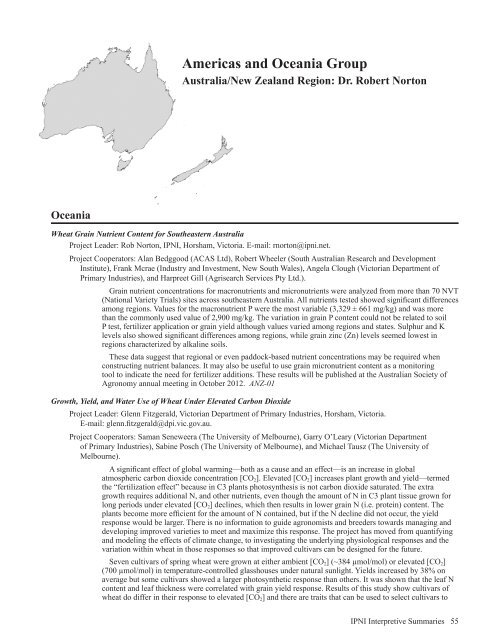Americas and Oceania Group - International Plant Nutrition Institute
Americas and Oceania Group - International Plant Nutrition Institute
Americas and Oceania Group - International Plant Nutrition Institute
You also want an ePaper? Increase the reach of your titles
YUMPU automatically turns print PDFs into web optimized ePapers that Google loves.
<strong>Americas</strong> <strong>and</strong> <strong>Oceania</strong> <strong>Group</strong><br />
Australia/New Zeal<strong>and</strong> Region: Dr. Robert Norton<br />
<strong>Oceania</strong><br />
Wheat Grain Nutrient Content for Southeastern Australia<br />
Project Leader: Rob Norton, IPNI, Horsham, Victoria. E-mail: rnorton@ipni.net.<br />
Project Cooperators: Alan Bedggood (ACAS Ltd), Robert Wheeler (South Australian Research <strong>and</strong> Development<br />
<strong>Institute</strong>), Frank Mcrae (Industry <strong>and</strong> Investment, New South Wales), Angela Clough (Victorian Department of<br />
Primary Industries), <strong>and</strong> Harpreet Gill (Agrisearch Services Pty Ltd.).<br />
Grain nutrient concentrations for macronutrients <strong>and</strong> micronutrients were analyzed from more than 70 NVT<br />
(National Variety Trials) sites across southeastern Australia. All nutrients tested showed significant differences<br />
among regions. Values for the macronutrient P were the most variable (3,329 ± 661 mg/kg) <strong>and</strong> was more<br />
than the commonly used value of 2,900 mg/kg. The variation in grain P content could not be related to soil<br />
P test, fertilizer application or grain yield although values varied among regions <strong>and</strong> states. Sulphur <strong>and</strong> K<br />
levels also showed significant differences among regions, while grain zinc (Zn) levels seemed lowest in<br />
regions characterized by alkaline soils.<br />
These data suggest that regional or even paddock-based nutrient concentrations may be required when<br />
constructing nutrient balances. It may also be useful to use grain micronutrient content as a monitoring<br />
tool to indicate the need for fertilizer additions. These results will be published at the Australian Society of<br />
Agronomy annual meeting in October 2012. ANZ-01<br />
Growth, Yield, <strong>and</strong> Water Use of Wheat Under Elevated Carbon Dioxide<br />
Project Leader: Glenn Fitzgerald, Victorian Department of Primary Industries, Horsham, Victoria.<br />
E-mail: glenn.fitzgerald@dpi.vic.gov.au.<br />
Project Cooperators: Saman Seneweera (The University of Melbourne), Garry O’Leary (Victorian Department<br />
of Primary Industries), Sabine Posch (The University of Melbourne), <strong>and</strong> Michael Tausz (The University of<br />
Melbourne).<br />
A significant effect of global warming—both as a cause <strong>and</strong> an effect—is an increase in global<br />
atmospheric carbon dioxide concentration [CO 2 ]. Elevated [CO 2 ] increases plant growth <strong>and</strong> yield—termed<br />
the “fertilization effect” because in C3 plants photosynthesis is not carbon dioxide saturated. The extra<br />
growth requires additional N, <strong>and</strong> other nutrients, even though the amount of N in C3 plant tissue grown for<br />
long periods under elevated [CO 2 ] declines, which then results in lower grain N (i.e. protein) content. The<br />
plants become more efficient for the amount of N contained, but if the N decline did not occur, the yield<br />
response would be larger. There is no information to guide agronomists <strong>and</strong> breeders towards managing <strong>and</strong><br />
developing improved varieties to meet <strong>and</strong> maximize this response. The project has moved from quantifying<br />
<strong>and</strong> modeling the effects of climate change, to investigating the underlying physiological responses <strong>and</strong> the<br />
variation within wheat in those responses so that improved cultivars can be designed for the future.<br />
Seven cultivars of spring wheat were grown at either ambient [CO 2 ] (~384 µmol/mol) or elevated [CO 2 ]<br />
(700 µmol/mol) in temperature-controlled glasshouses under natural sunlight. Yields increased by 38% on<br />
average but some cultivars showed a larger photosynthetic response than others. It was shown that the leaf N<br />
content <strong>and</strong> leaf thickness were correlated with grain yield response. Results of this study show cultivars of<br />
wheat do differ in their response to elevated [CO 2 ] <strong>and</strong> there are traits that can be used to select cultivars to<br />
IPNI Interpretive Summaries 55

















